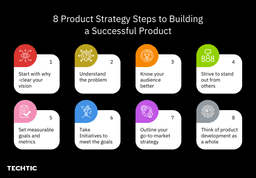8 Steps To A Winning Product Strategy Made Simple: What You Need To Know
Sector: Digital Product, UI/UX
Author: Nisarg Mehta
Date Published: 05/20/2022

Contents
You built a product, and it’s working well. You might even achieve your goals and start making a profit. But how do you know when you’re done building it? When do you need to create a new feature or add a new marketing channel?
When you bring a product to market, you’re solving a problem for your users. But you’re not the only person who can solve that problem. In fact, you’re one piece in a much larger ecosystem — a network of developers, customers, and manufacturers — all working together to build a better product. It’s a complex ecosystem, and you need a product strategy that can help you navigate it.
But What is a Product Strategy all about?
Product strategy is the roadmap for where a product is heading. It’s the “why” or “soul” of a product and sets the product apart from the competition. A well-planned product strategy helps you understand where the product is going, what it should look like when it gets there, and what it will mean for the user experience along the way. Moreover, it helps you keep track of what to build when to build it, and how to measure its success.
The role of product strategy is to help define and refine the strategy for a company’s product. This includes defining the goals for the product and setting out the roadmap for the product. It also includes determining the feature set for the product and the product roadmap and setting out the organizational structure for the product. Product strategy is a critical part of the product management function. It ultimately decides what features the product needs to be successful and sets the roadmap for the rest of the product team to build.
So, Why do you need a product strategy?
Product strategy is necessary because companies can’t keep up with the rapid change in their markets without it. Customers are changing their buying behavior, and many new products are trying to compete for their business.
In the past, companies could just sell what was best at the time. Today, companies need to make decisions in a hurry, and they need to know what the market wants. And that’s why you need an adaptive product strategy that ensures your products or product lines hit the market successfully. Product Strategy also offers many benefits, such as:
- Ensure the product development team is focused and aligned in the same direction;
- Guide project managers in prioritizing new features and resources;
- Help to find out optimum answers to solve your ideal customers’ problems;
- Simplify it for other departments to understand the product importance associated with the business goals;
- Lead you to your unique selling proposition—USP and help you differentiate your product from others in the market;
- Also help in attracting and convincing external stakeholders and inventors, ensuring product viability.
8 steps for a winning product strategy
Defining your product strategy is the process of figuring out what your product is, who your product is for, and what your product will do for your users and customers. Your product strategy should result from a strong understanding of your users, their problems, and the market you’re trying to reach.
It’s the roadmap for your product, and it will be the thing that keeps you and your product moving in the right direction toward your goals. So, let us see the ideal steps to create a winning product strategy right away!

Step 1- Start with why -clear your vision
We all have a vision of what success looks like in our products — some big features, a sleek design, and lots of happy customers. And it’s tempting to jump straight into the details of how your product will function and what features it should include. But if you don’t know where you’re going, how will you know when you get there?
In other words, without a clear vision of why you’re building the product in the first place, it’s impossible to create a successful outcome. A clear vision is a lens through which you will be able to answer the question, “why to build this product?” every time it arises. Once you have a concrete answer to why you are building what you are building, it will be your North Star that guides your product decisions, marketing strategies, and everything else you do. It’s what will separate you from the pack.
Step 2 - Understand the problem
There is no doubt that product strategy is a key part of business, with a lot of stakeholders and creative heads involved in the process. We have to understand the demand for our product and our competitive advantage, and it is a hard thing to do. Most importantly, we need to understand the problem our target customers have and create an offer that solves these problems.
You want to build something that solves a real problem your prospective customers face, and they would be ready to pay for it. To validate if your solution is what your target audience is looking for, you can take surveys, ask for feedback on your product idea, or ask customers to evaluate a hypothetical product. This way, you can create a product that appeals to and empathizes with the right audience in addition to solving their problems.
Step 3 - Know your audience better
The best product strategies are created with a deep understanding of the people who will use your product. This requires more than just a demographic analysis. It requires talking to people with different roles and responsibilities in the product so that you understand how they use the product and what their needs are.
You can better prioritize the features and changes you build when you know your audience better. Determining your target audience and understanding their motivations can help you create a winning product strategy. This will help you make a product people will actually want to use.
Step 4 - Strive to stand out from others
A product strategy is also a plan that defines how an organization will compete in the market with its products against existing ones. Therefore, in addition to identifying problems and knowing customers, you also need to understand your competitors. Analyzing your rival products is the only key to making your product better than theirs and finding a unique selling proposition.
A strong USP is crucial to give your audience a reason to buy your product over others which can be a feature, functionality, or enhanced customer experience.
Step 5 - Set measurable goals and metrics
The product strategy has to include measurable goals and metrics to measure the progress. Breaking down your goals into quantifiable elements lets you know when exactly you reach your goal. Metrics are how you measure your goal.
For example, increasing the number of registrations per month by 30% by the end of Q1. Here, you set a goal to increase the number of registrations; how much (30%) and by when (by the end of Q1) are the metrics you will measure your goal.
Step 6 - Take Initiatives to meet the goals
You have set measurable goals, but how will you meet them? You have to strategize actions and initiatives that lead you to achieve your goals on time. For example, to meet the goal of a 30% increase in registrations every month by Q1, you need to attract more customers first.
Step 7 - Outline your go-to-market strategy
The go-to-market strategy defines the different stages of a product launch life cycle. You create a marketing plan and outline a sales strategy utilizing the product USP in a go-to-market strategy. It works as a blueprint of how you will promote your product to reach the right audience in the market.
Basically, a go-to-market strategy (GTM) is a set of activities that a company uses to get its product to market. A GTM is an essential part of a product strategy because it ensures a successful product launch. The strategy also reduces time to market and costs associated with failed product launches.
Step 8 - Think of product development as a whole
A winning product strategy covers plans for everything from ideation and validation to development, launch, and enhancement post-launch. Hence, the last step of product strategy creation is to formulate a flexible plan for product development. Product development is an iterative process. Moreover, it comprises several stages, including planning, designing, testing, launching, and iterating as per feedback.
However, while you frame your product development strategy, you have to brainstorm how your product will move from MVP to alpha & beta and alpha & beta to production. Besides, an efficient product strategy encloses planning for future development as well.
In other words, your product strategy should also include planning for how you will scale your product to survive and thrive in the market and advance features to upgrade the product to attract a large number of users. This holistic approach will help in product scaling and upgrading, whether by adopting trends or following reviews from early adopters.
Ready to create an efficient product strategy?
A Product strategy is a process of identifying the features and functions of a product and deciding on the form and function. This involves thinking about the purpose or goal of a product and determining how best to design and create it. The result is a plan that defines the product you intend to make and the resources needed to develop it. It also describes how you will measure your product’s success and growth considering the market competition.
If you are looking for creative heads to help you create a surefire roadmap for your trailblazing product, you can connect with us. We have the right resources that will complement your product development team.
Latest Tech Insights!
Join our newsletter for the latest updates, tips, and trends.







